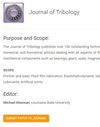Dimensional discussion of traction force vector on ball/raceway interface and study of bearing dynamic behavior
IF 3
3区 工程技术
Q2 ENGINEERING, MECHANICAL
引用次数: 0
Abstract
As a crucial component, rolling bearings directly determine the reliability of rotating equipment. However, current dynamic models for predicting the bearing performance either ignore the velocity and stress dispersion at the ball/raceway interface or fail to consider the spin moment generated within the interface. To address this issue, the discrete features of the velocity and stress distribution are considered in this paper, and the micro-element approach is used to construct formulas to obtain the traction vectors in two and three dimensions, respectively. Two bearing dynamic models are further developed for these two types of equations: one model considers the spin moment at the interface owing to unequal contact angles between the ball and the two raceways, while the other model ignores this moment. The reliability of these models is validated by comparison with experimental test results, including cage speed and oil film thickness. The predictions from the quasi-static model are used as theoretical values to compare the ability of the two models to simulate bearing performance under different operating conditions. The results show that the prediction results of the model considering the spin moment are closer to the theoretical values than those of the model ignoring this moment. However, the moment increases the friction at the ball/raceway interface, causing this model to underestimate the extent of bearing sliding.滚珠/滚道界面牵引力矢量的量纲讨论及轴承动态特性研究
滚动轴承作为一个关键部件,直接决定着旋转设备的可靠性。然而,目前用于预测轴承性能的动力学模型要么忽略了球/滚道界面处的速度和应力分散,要么没有考虑界面内产生的旋转力矩。为了解决这个问题,本文考虑了速度和应力分布的离散特征,并使用微元方法构造公式,分别获得二维和三维的牵引矢量。针对这两种类型的方程,进一步开发了两个轴承动力学模型:一个模型考虑了由于球和两个滚道之间的接触角不相等而导致的界面处的旋转力矩,而另一个模型忽略了该力矩。通过与包括保持架速度和油膜厚度在内的实验测试结果的比较,验证了这些模型的可靠性。准静态模型的预测被用作理论值,以比较两个模型在不同操作条件下模拟轴承性能的能力。结果表明,考虑自旋矩的模型预测结果比忽略自旋矩的预测结果更接近理论值。然而,力矩增加了滚珠/滚道界面处的摩擦力,导致该模型低估了轴承滑动的程度。
本文章由计算机程序翻译,如有差异,请以英文原文为准。
求助全文
约1分钟内获得全文
求助全文
来源期刊
CiteScore
4.20
自引率
12.00%
发文量
117
审稿时长
4.1 months
期刊介绍:
The Journal of Tribology publishes over 100 outstanding technical articles of permanent interest to the tribology community annually and attracts articles by tribologists from around the world. The journal features a mix of experimental, numerical, and theoretical articles dealing with all aspects of the field. In addition to being of interest to engineers and other scientists doing research in the field, the Journal is also of great importance to engineers who design or use mechanical components such as bearings, gears, seals, magnetic recording heads and disks, or prosthetic joints, or who are involved with manufacturing processes.
Scope: Friction and wear; Fluid film lubrication; Elastohydrodynamic lubrication; Surface properties and characterization; Contact mechanics; Magnetic recordings; Tribological systems; Seals; Bearing design and technology; Gears; Metalworking; Lubricants; Artificial joints

 求助内容:
求助内容: 应助结果提醒方式:
应助结果提醒方式:


